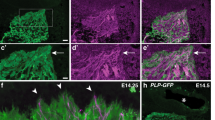Summary
Several lines of evidence suggest that glial cells have major effects on neuronal pathfinding. We have examined in vitro whether the outgrowth pattern of Xenopus retinal fibres is influenced by the glial cells encountered as they grow to the optic tectum. Strips of retina were cultured on monolayers of glial cells from the diencephalon and from the rostral and caudal ends of the optic tectum. On glia from the caudal end of the tectum the growth of fibres from the nasal and temporal ends of the strips was different: temporal fibres were shorter and more fasciculated than nasal fibres. This difference was still discernible on glia isolated from the rostral end of the tectum, but to a lesser extent. On glia from the diencephalon there was no difference between nasal and temporal fibres.
Similar content being viewed by others
References
Agranoff BW, Field P, Gaze RM (1976) Neurite outgrowth from explanted Xenopus retina: an effect of prior optic nerve section. Brain Res 113:225–234
Beach PM, Jacobson M (1979) Pattern of cell proliferation in the retina of the clawed frog during development. J Comp Neurol 183:603–611
Bonhoeffer F, Gierer A (1984) How do retinal axons find their targets on the tectum? Trends Neurosci 7:378–381
Bonhoeffer F, Huf J (1980) Recognition of cell types by axonal growth cones in vitro. Nature 288:162–165
Bonhoeffer F, Huf J (1982) In vitro experiments on axon guidance demonstrating an anterior-posterior gradient on the tectum. EMBO J 1:427–431
Cox EC, Muller B, Bonhoeffer F (1990) Axonal guidance in the chick visual system: posterior tectal membranes induce collapse of growth cones from the temporal retina. Neuron 4:31–37
Davies JA, Cook GMW, Stern CD, Keynes RJ (1990) Isolation from chick somites of a glycoprotein fraction that causes collapse of dorsal root ganglion growth cones. Neuron 4:11–20
Gooday DJ (1990) Retinal axons in Xenopus laevis recognise differences between tectal and diencephalic glial cells in vitro. Cell Tissue Res 259:595–598
Grant P, Tseng Y (1986) Embryonic and regenerating Xenopus retinal fibres are intrinsically different. Dev Biol 114:475–491
Guillery RW, Walsh C (1987) Changing glial organisation relates to changing fiber order in the developing optic nerve of ferrets. J Comp Neurol 265:203–217
Halfter W (1989) Antisera to basal lamina and glial endfeet disturb the normal extension of axons on retina and pigment epithelium basal laminae. Development 107:281–297
Halfter W, Deiss S (1984) Axon growth in embryonic chick and quail retinal whole mounts in vitro. Dev Biol 102:344–355
Halfter W, Newgreen DF, Sauter J, Schwarz U (1983) Oriented axon outgrowth from avian embryonic retinae in culture. Dev Biol 95:56–64
Hammarback JA, McCarthy JB, Palm SL, Furcht LT, Letourneau PC (1988) Growth cone guidance by substrate-bound laminin pathways is correlated with neuron-to-pathway adhesivity. Dev Biol 126:29–39
Jacobson M (1976) Histogenesis of retina in the clawed frog with implications for the pattern of development of retinotectal connections. Brain Res 103:541–545
Kapfhammer JP, Grunewald BE, Raper JA (1986) The selective inhibition of growth cone extension by specific neurites in cultures. J Neurosci 6:2527–2534
Kapfhammer JP, Raper JA (1987a) Collapse of growth cone structure on contact with specific neurites in culture. J Neurosci 7:201–212
Kapfhammer JP, Raper JA (1987b) Interactions between growth cones and neurites growing from different neural tissues in cultures. J Neurosci 7:1595–1600
Keynes RJ, Stern CD (1984) Segmentation in the vertebrate nervous system. Nature 310:786–789
Keynes RJ, Stern CD (1988) Mechanisms of vertebrate segmentation. Development 103:413–429
Landreth GE, Agranoff BW (1979) Explant culture of goldfish retina: a model for the study of CNS regeneration. Brain Res 161:39–53
Maggs A, Scholes J (1986) Glial domains and nerve fibre patterns in the fish retinotectal pathway. J Neurosci 6:424–438
Nieuwkoop PD, Faber J (1967) A normal table of Xenopus laevis (Daudin). North Holland, Amsterdam
Patterson PH (1988) On the importance of being inhibited, or saying no to growth cones. Neuron 1:263–267
Raper JA, Kapfhammer JP (1990) The enrichment of a neuronal growth cone collapsing activity from embryonic chick brain. Neuron 4:21–29
Silver J, Rutishauser U (1984) Guidance of optic axons by a preformed adhesive pathway on neuroepithelial endfeet. Dev Biol 106:485–499
Straznicky K, Gaze RM (1972) The development of the tectum in Xenopus laevis: an autoradiographic study. J Embryol Exp Morphol 28:87–115
Straznicky C, Hiscock J (1984) Postmetamorphic retinal growth in Xenopus. Anat Embryol 169:103–109
Vielmetter J, Stuermer CAO (1989) Goldfish retinal axons respond to position-specific properties of tectal cell membranes in vitro. Neuron 2:1331–1339
Walter J, Kern-Veits B, Huf J, Stolze B, Bonhoeffer F (1987a) Recognition of position-specific properties of tectal cell membranes by retinal axons in vitro. Development 101:685–696
Walter J, Henke-Fahle S, Bonhoeffer F (1987b) Avoidance of posterior tectal membranes by temporal retinal axons. Development 101:909–913
Author information
Authors and Affiliations
Rights and permissions
About this article
Cite this article
Jack, J., Gooday, D., Wilson, M. et al. Retinal axons in Xenopus show different behaviour patterns on various glial substrates in vitro. Anat Embryol 183, 193–203 (1991). https://doi.org/10.1007/BF00174399
Accepted:
Issue Date:
DOI: https://doi.org/10.1007/BF00174399




